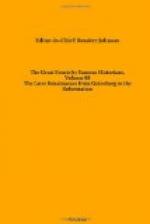I have dwelt at length upon the map of La Cosa, because, for our northern coasts, it is in effect John Cabot’s map. After the return of the second expedition, the English made a few voyages, but soon fell back into the old rut of their Iceland trade. The expedition was beyond question a commercial failure, and therefore, like the practical people they are, they neglected that new continent which was destined to become the chief theatre for the expansion of their race. Their fishermen were for many years to be found in small numbers only on the coast, and, as before, their supply of codfish was drawn from Iceland, where they could sell goods in exchange.
Meantime the Bretons and Normans, and the Basques of France and Spain, and the Portuguese grasped that which England practically abandoned. That landfall which Cabot gave her in 1497 cost much blood and treasure to win back in 1758. The French fishermen were on the coast as early as 1504, and the names on La Cosa’s map were displaced by French names still surviving on the south coast and on what is called the “French shore” of Newfoundland. Robert Thorne in 1527—and no doubt others unrecorded—in vain urged upon the English government to vindicate its right. According to the papal bulls and the treaty of Tordesillas, the new lands were Portuguese east of a meridian three hundred seventy leagues west of the Cape de Verd Islands and Spanish to the west of it. Baccalaos and Labrador were considered to be Portuguese; and, upon the maps, when any mention is made of English discoveries they are accordingly relegated to Greenland or the far north of Labrador. The whole claim of England went by abandonment and default. The Portuguese, as the Rev. Dr. Patterson has shown, named all the east coast of Newfoundland, and their traces are even yet found on the coasts of Nova Scotia and of Cape Breton.
Therefore it is that the maps we have now to refer to are not so much Spanish as Portuguese. They will tell us nothing of the English, nor of Cabot, but we shall be able to follow his island of St. John—the only one of his names which survived. The outlines of some very early maps are given by Kunstmann, Kretschmer, and Winsor, but until 1505 they have no bearing upon our problem. In that year Reinel’s map was made, and, although Newfoundland forms part of terra firma, the openings north and south of it are plainly indicated by unclosed lines. Cape Race has received its permanent name, “Raso” and, although only the east coast of Newfoundland is named, there is no possibility of mistaking the easternmost point of Cape Breton. Just opposite (ex adverso) is laid down and named the island of Sam Joha, in latitude 46 deg., the precise latitude of Scatari Island. Here, then, in 1505, is in this island of St. John an independent testimony to the landfall of 1497—not off Cape North, which does not yet appear, nor inside the gulf, for it is not even indicated—but in the Atlantic Ocean, at the cape of Cape Breton—the “Cavo descubierto” of La Cosa.




